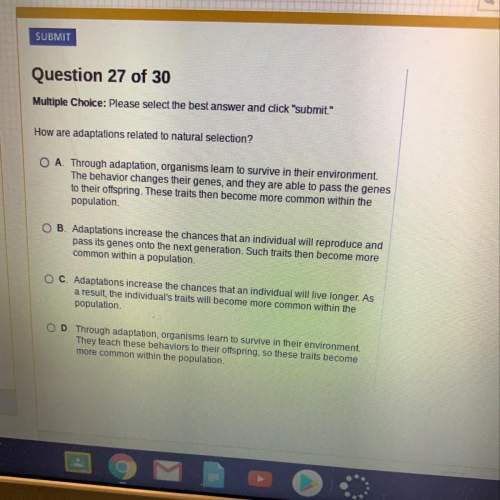
Virtual Cell Division Lab Report
Instructions: The Virtual Cell Division Lab is on the 03.01 lesson assessment page. On the image, it says “Click Anywhere to Start”. Follow the instructions as you move through the lab. The lab activity will keep count of your data on the right and you can record this into the data table at the end of each trial.
Title:
Objective(s):
Hypothesis:
Data:
Record the number of cells you observed in each part of the lab activity.
Number of Cells in Part 1 Number of Cells in Part 2
Interphase
Prophase
Metaphase
Anaphase
Telophase
Cytokinesis
Observations:
Record any observations about the cells you observed. What does the cell look like for each stage? What is a distinguishing visible feature of each stage of the cell cycle?
Description of cell
Interphase
Prophase
Metaphase
Anaphase
Telophase
Cytokinesis
Data Analysis:
Part 1: Calculate the percentage of the cell cycle spent in each stage. Number of cells in given stage ÷ total number of cells counted × 100 = % of the cell cycle spent in this stage
Part 2: Using your percentages in part 1 please create a chart that represents the time spent in each stage of the cell cycle.
Insert chart [Hint: don’t forget to consider the relationship between your data and the type of chart to best represent your data]
Conclusion:
Be sure to answer the following reflection questions as a summary in the conclusion of your lab report:
Was your hypothesis correct? Why or why not?
Based on your data, what can you infer about the length of time spent in each stage of the cell cycle?
What stages were the longest and shortest? Give a brief explanation of why these stages may have that time period.
Questions:
Using what you have learned in the lesson and the virtual lab activity, answer the following questions in complete sentences.
What differences can you see when you compare the nucleus of a dividing cell with that of a non-dividing cell?
If your observation had not been restricted to the tip of the onion root, how would the results be different?
Virtual Lab Instructions
Background Information:
The root tips of onion plants are commonly used for observing cell division because:
The onion plants are easy to grow in large numbers.
The cells at the tip of the onion roots are actively dividing, so many of the cells will be in stages of mitosis.
The root tips can be prepared in a way that allows them to be flattened on the microscope slide so that the chromosomes of individual cells can be observed.
This species has a relatively small number of chromosomes, and they are fairly large and distinct.
There are three cellular regions near the tip of an onion root.
The root cap contains cells that cover and protect the underlying growth region as the root pushed through the soil.
The region of cell division is where cells are actively dividing but not increasing significantly in size.
In the region of cell elongation, cells are increasing in size but not dividing.
We will be observing cells in the region of cell division to ensure that we observe all stages of mitosis and the cell cycle.
Onion root tip, region of cell elongation, followed by region of cell division, ending in a protective root cap
For this lab activity, you will be examining a section of an onion root tip under a compound light microscope. These slides were prepared by slicing the roots into thin sections, mounting them on glass microscope slides, staining so that the chromosomes are more visible, and then covering the specimen with a cover slip.
The images below give examples of what you might see in each of the stages of the cell cycle.
illustration of the stages of mitosis
Print

Answers: 3
Other questions on the subject: Biology

Biology, 21.06.2019 16:40, georgesarkes12
Which hotel do you think is most likely to move ahead in market competition? a. a hotel that provides basic amenitiesb. a hotel that provides luxurious amenitiesc. a hotel that shows understanding of customers' latent needsd. a hotel that gives discounts
Answers: 2

Biology, 22.06.2019 01:00, lizzyhearts
Mr. olajuwan was in a horrific snowmobile accident. afterwards he had trouble walking and he had a loss of balance. which of the 4 major brain region was probably demaged
Answers: 1

Biology, 22.06.2019 09:00, werewolf4751
Which of these is an example of land degradation? a. containers designed to store pollutants leak. b. fertilizers provide too many nutrients to crops. c. garbage is buried so the land can be reclaimed later. d. a drought kills all the plants in an area, leaving bare land
Answers: 3

Biology, 22.06.2019 17:00, briannagiddens
Astudent completed a lab report. which correctly describes the difference between the “question” and “hypothesis” sections of her report? “question” states what she is asking, and “hypothesis” states the result of her experiment. “question” states what she is asking, and “hypothesis” states what she thinks the answer to that question is in “if . . then . . because” format. “question” describes what she is trying to find out, and "hypothesis" states the procedures and methods of data collection. “question” describes what she is trying to find out, and “hypothesis” states any additional information or prior knowledge about the question.
Answers: 1
Do you know the correct answer?
Virtual Cell Division Lab Report
Instructions: The Virtual Cell Division Lab is on the 03.01 lesson...
Questions in other subjects:

Biology, 17.09.2019 12:30


English, 17.09.2019 12:30

English, 17.09.2019 12:30

Mathematics, 17.09.2019 12:30


Biology, 17.09.2019 12:30

Mathematics, 17.09.2019 12:30


Chemistry, 17.09.2019 12:30







